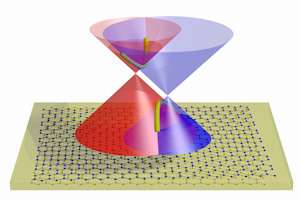Layered graphene sandwich for next generation electronics

Sandwiching layers of graphene with white graphene could produce designer materials capable of creating high-frequency electronic devices, University of Manchester scientists have found.
Writing in Nature Nanotechnology, the researchers have demonstrated how combining the two-dimensional materials in a stack could create perfect crystals capable of being used in next generation transistors.
Hexagonal boron nitride (hBN), otherwise known as white graphene, is one of a family of two-dimension materials discovered in the wake of the isolation of graphene at the University in 2004. Manchester researchers have previously demonstrated how combining 2D materials, in stacks called heterostructures, could lead to materials capable of being designed to meet industrial demands.
Now, for the first time, the team has demonstrated that the electronic behaviour of the heterostructures can be changed enormously by precisely controlling the orientation of the crystalline layers within the stacks.
The researchers, led by University of Manchester Nobel laureate Sir Kostya Novoselov, carefully aligned two graphene electrodes separated by hBN and discovered there was a conservation of electron energy and momentum.
The findings could pave the way for devices with ultra-high frequencies, such as electronic or photovoltaic sensors.
The research was carried out with scientists from Lancaster and Nottingham Universities in the UK, and colleagues in Russia, Seoul and Japan.
Professor Laurence Eaves, a joint academic from the Universities of Manchester and Nottingham, said: ""This research arises from a beautiful combination of classical laws of motion and the quantum wave nature of electrons, which enables them to flow through barriers.
"We are optimistic that further improvements to the device design will lead to applications in high-frequency electronics."
Professor Vladimir Falko, from Lancaster University, added: "Our observation of tunnelling and negative differential conductance in devices made of multilayers of graphene and hexagonal boron nitride demonstrates potential that this system has for electronics applications.
"It is now up to material growers to find ways to produce such multilayer systems using growth techniques rather than mechanical transfer method used in this work."
More information: 'Twist-controlled resonant tunnelling in graphene/boron nitride/graphene heterostructures, by A. Mishchenko, J. S. Tu, Y. Cao, R. V. Gorbachev, J. R.Wallbank, M. T. Greenaway, V. E. Morozov, S. V. Morozov, M. J. Zhu, S. L. Wong, F. Withers, C. R. Woods, Y-J. Kim, K. Watanabe, T. Taniguchi, E. E. Vdovin, O. Makarovsky, T. M. Fromhold, V. I. Fal'ko, A. K. Geim, L. Eaves and K. S. Novoselov, Nature Nanotechnology September 7. DOI: 10.1038/nnano.2014.187
Journal information: Nature Nanotechnology
Provided by University of Manchester










.jpg)








